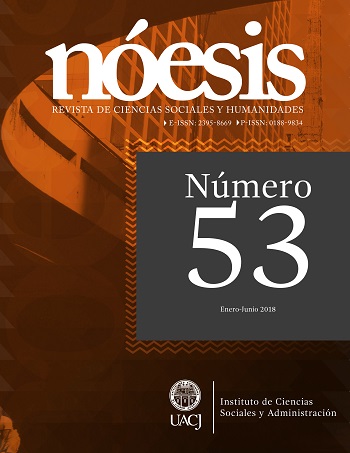Central american minors prostituted in California
Main Article Content
Abstract
Downloads
Article Details

This work is licensed under a Creative Commons Attribution-NonCommercial-ShareAlike 4.0 International License.
References
Almodovar, Norma. 1999. For their own good: the results of the prostitution laws as enforced by cops, politicians and judges. Hastings Women's Law Journal 10: 119-133.
Andrade, Karla. 2016. Víctimas de trata: mujeres migrantes, trabajo agrario y acoso sexual en Tamaulipas. CienciaUAT, 11(1): 22-36.
Benjamin, Harry y Robert Masters. 1964. Prostitution and morality: A definitive report on the prostitute in contemporary society and an analysis of the causes and effects of the suppression of prostitution. Nueva York: Julian Press.
Berkowitz, Eric. 2015. The boundaries of desire. A century of bad laws, good sex and changing identities. Berkeley, California: Counterpoint.
Bourdieu, Pierre. 2012. Symbolic violence. Revista Latina de Sociología, 2: 1-4.
Brents, Bárbara, Crystal Jackson y Kathryn Hausbeck. 2010. The state of sex. Tourism, sex and sin in the new american heartland. Nueva York: Routledge.
Busick, Rachel. 2015. Blurred lines or bright line-addressing the demand for sex trafficking under California law. Pepperdine Law Review 42 (2): 333-376.
Carter, Laura. 2013. Revising California policies on human trafficking will help protect victims. UCLA Center for the Study of Women Policy Brief 16: 1-3.
Donato, Katharine y Blake Sisk. 2015. Children's migration to the United States from Mexico and Central America: Evidence from the Mexican and Latin American migration projects. Journal on Migration and Human Security 3 (1): 58-79. DOI: https://doi.org/10.14240/jmhs.v3i1.43
Farrell, Amy. 2014. Environmental and institutional influences on police agency responses to human trafficking. Police Quarterly 17 (1): 3-29. DOI: https://doi.org/10.1177/1098611113495050
Fichtelman, Ellen. 2014. The double entendre of juvenile prostitution: Victim versus delinquent and the necessity of State uniformity. Juvenile & Family Court Journal 65 (3/4): 27-46. DOI: https://doi.org/10.1111/jfcj.12021
Gallagher, Anne. 2010. The international law of human trafficking. Nueva York, Cambridge University Press.
Halter, Stephanie. 2010. Factors that influence police conceptualizations of girls involved in prostitution in six U.S. Cities: Child sexual exploitation victims or delinquents? Child Maltreatment 15 (2): 152-160. DOI: https://doi.org/10.1177/1077559509355315
Hepburn, Stephanie y Rita Simon. 2013. Human trafficking around the world. Hidden in plain sight. Nueva York: Columbia University Press.
Izcara, Simón y Karla Andrade. 2015. Causas e impactos de la deportación de migrantes centroamericanos de Estados Unidos a México. Estudios Fronterizos, 16 (31): 239-271
Jennings, Anne. 1976. The victim as criminal: A consideration of California’s prostitution law. California Law Review 64 (5): 1235-1286. DOI: https://doi.org/10.2307/3480055
Kinsey, Alfred, Wardell Pomeroy y Clyde Martin. 1948. Sexual behavior in the human male. Philadelphia: WB Saunders.
Kumar, Arun y Adriana Salas (2008). Algunas consideraciones teóricas acerca del tráfico de mujeres en el contexto de la globalización. Revista de Ciencias Sociales, 14(2): 220-239.
Machín, Macarena. 2015. Menores y migración: un acercamiento a los tipos de violencia en Centroamérica con énfasis en los y las menores migrantes no acompañados. ODISEA. Revista de Estudios Migratorios 2: 391-413.
Michael, Robert, John Gagnon, Edward Laumann y Gina Bari. 1994. Sex in America: A definitive survey. Boston: Little Brown.
Mitchell, Kimberly, David Finkelhor y Janis Wolak. 2010. Conceptualizing juvenile prostitution as child maltreatment: Findings from the national juvenile prostitution study. Child Maltreatment, 15 (1): 18-36. DOI: https://doi.org/10.1177/1077559509349443
Monto, Martin y Christine Milrod. 2013. Ordinary or peculiar men? Comparing the customers of prostitutes with a nationally representative sample of men. International Journal of Offender Therapy and Comparative Criminology, 20 (10): 1-19.
O’Brien, Erin. 2015. Prostitution ideology and trafficking policy: The impact of political approaches to domestic sex work on human trafficking policy in Australia and the United States. Journal of Women, Politics & Policy 36 (2): 191-212. DOI: https://doi.org/10.1080/1554477X.2015.1019277
Orozco y Villa, Luz. 2012. Trabajo sexual y trata de personas en México: Una defensa de la distinción. En Las mujeres a través del derecho penal, compilado por Juan Cruz y Rodolfo Vázquez, pp. 1-54. México: Fontamara.
O’Connell, Julia. 2006. Will the real sex slave please stand up? Feminist Review 83: 4-22.
DOI: https://doi.org/10.1057/palgrave.fr.9400278
Riegler, April. 2007. Missing the mark: Why the trafficking victims protection act fails to protect sex trafficking victims in the United States. Harvard Journal of Law and Gender 30: 231-256.
Risley, Amy. 2010. Sex trafficking: The “other” crisis in Mexico? The Latin Americanist, 54 (1):99-117. DOI: https://doi.org/10.1111/j.1557-203X.2010.01060.x
Shelley, Louise. 2010. Human trafficking. A global perspective. Nueva York: Cambridge University Press.
Ulloa, Teresa. 2011. La prostitución, una de las expresiones más arcaicas y violentas del patriarcado contra las mujeres. Pensamiento Iberoamericano 9: 293-312.

